Is White Rice Healthy? 7 Effects of Eating It
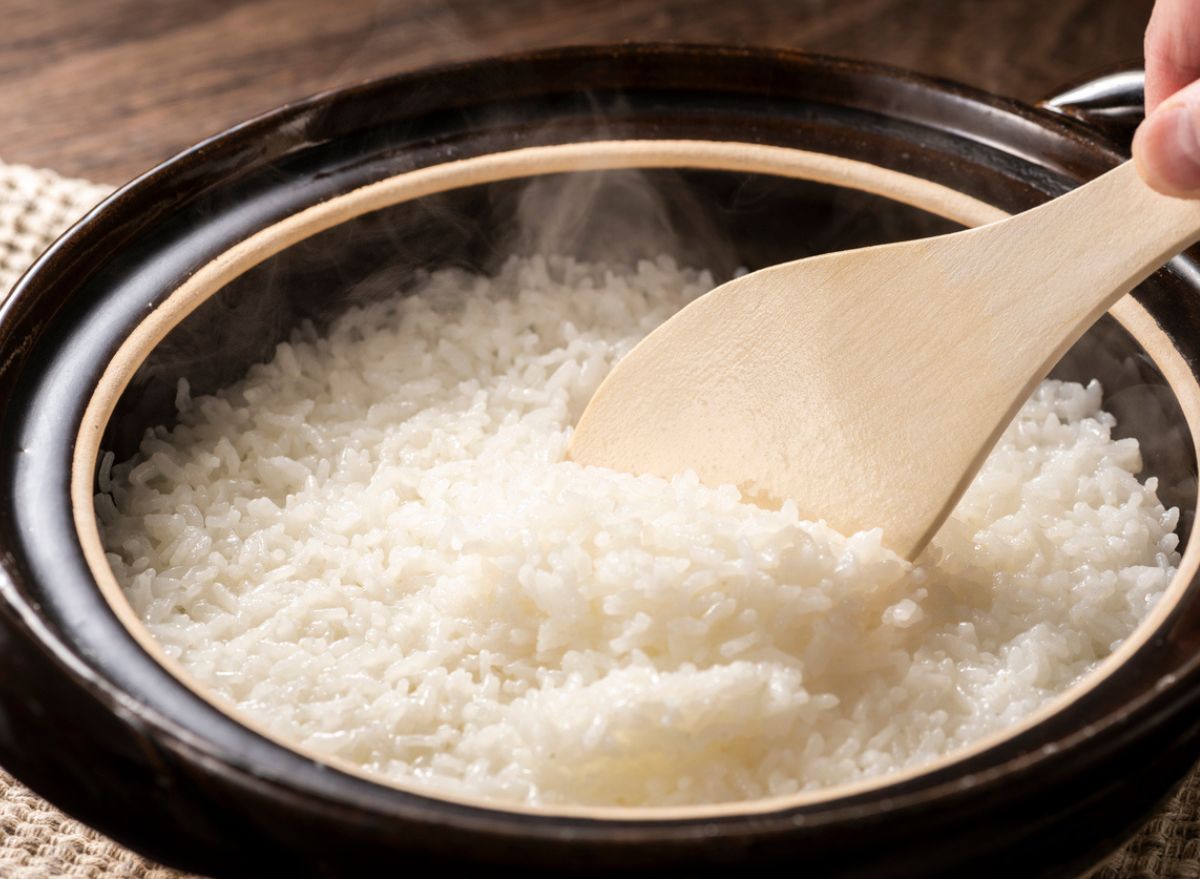
You'd be hard-pressed to find someone who didn't enjoy white rice. It's versatile, comforting, and can absorb any flavor you throw at it. Whether it's the base of a burrito bowl or wrapped into one, rolled into your favorite fresh sushi, or just used as a side item to your favorite vegetable and protein dish, this grain is truly loved by many. However, knowing that it's more processed than other types of rice, many rice lovers may be questioning its nutritional value and asking the important question: Is white rice healthy?
A loaded question, it has many complex answers. On the one hand, white rice is low in fat and reasonably low in calories, and it can be used in various healthy dishes. Conversely, white rice undergoes a good amount of processing, where the bran, germ, and husk are removed—and most of its fiber and nutrients along with it.
In order to learn more about the potential benefits and risks of eating this popular grain, we recruited the help of a few expert dietitians. Read on, and for more on your favorite carbohydrates, check out 6 Healthiest Breads to Eat for Weight Loss, Dietitians Say.
A look at the nutrition info
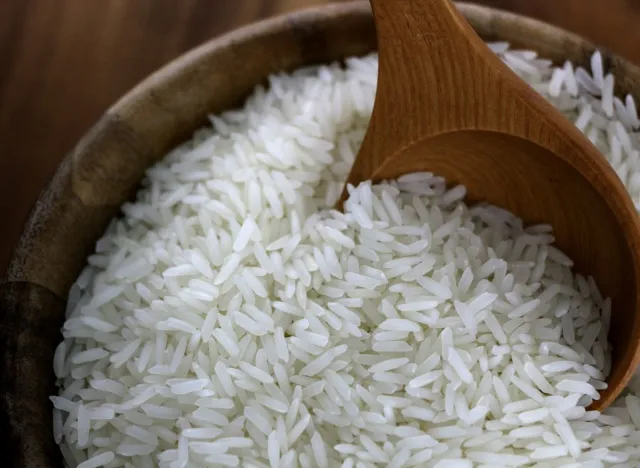
One cup of cooked white rice contains:
Macronutrients:
- 242 calories
- 4.4 grams of protein
- 0.4 grams of fat
- 53.2 g carbohydrates
- 0.6 g fiber
Micronutrients:
- 5.6 milligrams of calcium
- 3.7 micrograms of folate
- 53.9 milligrams of potassium
- 68.8 milligrams of phosphorus
- 24.2 milligrams of magnesium
- 0.4 milligrams iron
How the nutrition for a cup of cooked brown rice stacks up in comparison:
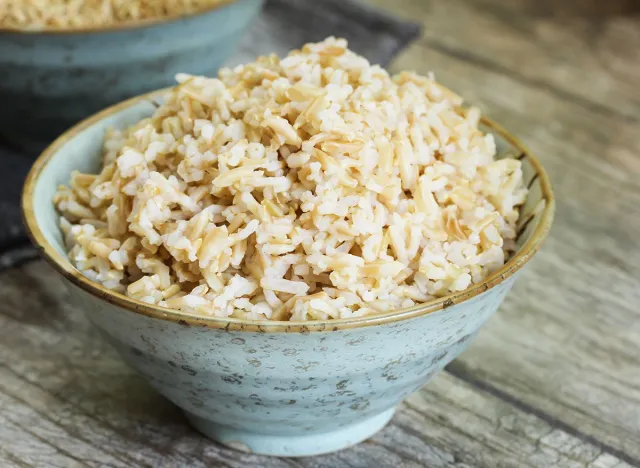
Macronutrients:
- 218 calories
- 4.5 g grams of protein
- 1.62 grams of fat
- 45.8 grams of carbohydrates
- 3.51 grams of fiber
Micronutrients:
- 19.5 milligrams calcium
- 7.8 micrograms folate
- 154 milligrams of potassium
- 150 milligrams of phosphorus
- 85.8 milligrams of magnesium
- 1.2 milligrams of iron
4 benefits of white rice
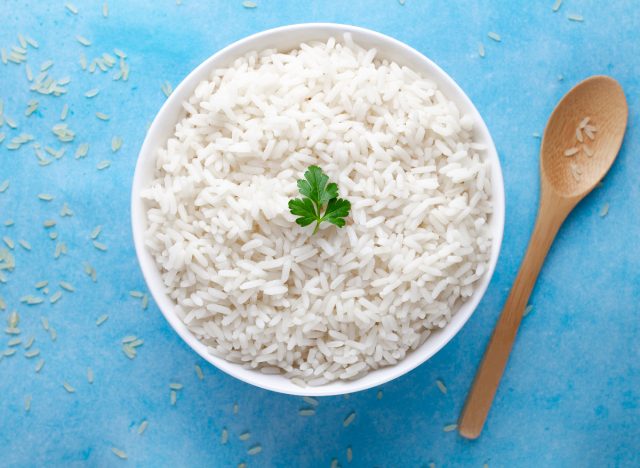
1. It is a source of energy
According to Trista Best, MPH, RD, LD at Balance One Supplements, white rice "is a high-carbohydrate food that provides a quick and easily digestible source of energy, and it can be particularly beneficial for individuals engaging in physical activities or needing a quick energy boost."
Carbohydrates naturally provide your body with energy whenever you eat them, but the specific effect it has depends on the type of carb. For instance, refined sugars and grains are going to be absorbed more quickly into the bloodstream because they lack fiber, meaning you may get an immediate boost of energy, but you may feel a crash later on. Whole grains and other complex carbs—like starchy vegetables or legumes—will give you slower, more sustained energy. So, white rice can provide you with an "energy boost," but it may not last as long as if you were to eat brown rice or another whole grain.
2. White rice is a gluten-free grain option
One healthy benefit of white rice is that it is entirely gluten-free, "making it suitable for individuals with gluten sensitivities or celiac disease," says Best. "It can be a valuable staple for those following a gluten-free diet and seeking alternative grain options."
However, if you're someone who needs to avoid gluten for medical reasons, you may want to talk with your doctor or dietitian before incorporating white rice. There may be better gluten-free grain options for your specific health needs.
3. Even though it's refined, it still contains some nutrients
As we mentioned earlier, white rice is a processed grain, meaning many of the nutrients are stripped from the grain before its put on grocery store shelves. However, this type of rice still contains some macro and micronutrients that are helpful for your overall health.
"Despite its refined nature, white rice contains essential nutrients such as folate, thiamin, and iron, which contribute to overall nutritional intake," says Mary Sabat MS, RDN, LD.
So, even though it has lower levels of nutrients than something like brown rice, not all is lost.
4. It is low in fat and cholesterol
Again, a lot depends on what your specific health goals and nutritional needs are. Still, Sabat adds that white rice "is naturally low in fat and cholesterol, making it a suitable choice for individuals aiming to manage their weight or maintain heart health."
However, if you're watching your overall heart health or trying to lower your cholesterol, Harvard Health says that whole grains are crucial due to their fiber content. So, if you want to eat white rice because of its low fat and cholesterol content, just make sure you balance it with other whole grains throughout your day.
3 downsides to white rice
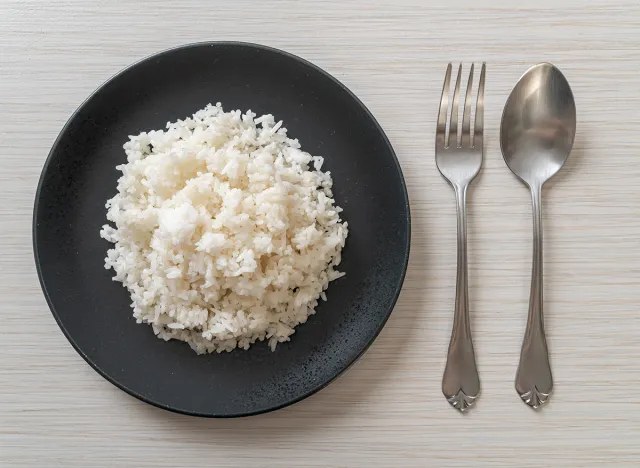
1. There are fewer nutrients than other grains
"Compared to other whole grains, white rice is more processed and stripped of its bran and germ, resulting in a lower nutritional content," says Best.
"The refining process removes a significant portion of essential vitamins, minerals, and antioxidants present in the outer layers of rice, and compared to brown rice, which retains these nutrients, white rice offers fewer health-promoting compounds," adds Sabat.
For instance, brown rice not only contains more fiber than white rice—3.5 grams in brown rice versus 0.6 grams in white— but also brown rice has higher levels of other micronutrients, including iron, folate, and magnesium.
2. White rice has a high glycemic index
According to both Best and Sabat, one potential downside of eating white rice is that it has a high glycemic index (GI). This means that it has a greater chance of spiking your blood sugar more rapidly than foods with a lower glycemic index. This is because it doesn't take long for your body to process white rice.
"This can be problematic for individuals with diabetes or those seeking to manage blood sugar levels," says Best. "So opting for whole grain alternatives may be more beneficial in this regard." Sabat also adds that "consuming white rice in moderation and pairing it with fiber-rich foods can help mitigate this effect [on your blood sugar]."
Another important thing to consider is something the UK-based National Health Service (NHS) eloquently points out concerning GI levels relative to a food's healthfulness: "Foods with a high GI are not necessarily unhealthy and not all foods with a low GI are healthy. For example, watermelon and sometimes parsnips are high GI foods, while chocolate cake has a lower GI value," the NHS reports.
This means that, yes—it matters how much a food spikes your blood sugar, especially if you are trying to watch your blood sugar levels. However, to effectively determine if a food is genuinely healthy or not, it's important to assess the overall effect of a food item as a whole.
3. It lacks fiber
Arguably one of the most impactful differences between white rice and other types of rice is the lack of fiber.
"The refining process of white rice removes the fiber content, which is essential for digestive health and maintaining satiety," says Best. "Without fiber, white rice can be less filling, leading to potential overeating or less control over portion sizes."
"Insufficient fiber intake can contribute to digestive issues, such as constipation, and may increase the risk of certain diseases like colon cancer," adds Sabat.
If you're using white rice as the carbohydrate in your meal, just make sure you find other ways to sprinkle in some fiber, such as vegetables, fruit, or beans.
RELATED: 44 Best High-Fiber Foods for a Healthy Diet
So, is white rice healthy?
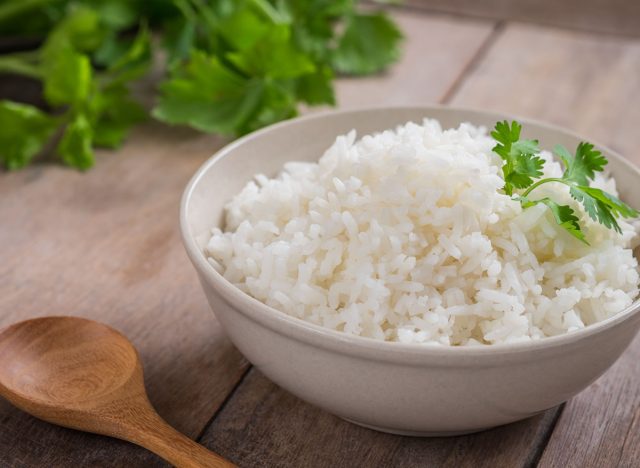
As you can see, determining whether or not white rice is actually healthy is tricky to determine. The lack of fiber and nutrients, as well as the fact that it has a high glycemic index, makes white rice a choice that isn't as beneficial as other types of unrefined rice or whole grains.
However, if you need a delicious carbohydrate for your meal—especially something gluten-free—white rice may be a good choice, as long as it's consumed in moderation. Just when you do eat it, ensure you're "incorporating a variety of other nutrient-dense foods alongside your white rice," advises Sabat.
"Considering the potential side effects, consuming it in moderation, and diversifying the diet with healthier alternatives is advised for individuals aiming for optimal health and nutrition," says Sabat.
- Source: https://fdc.nal.usda.gov/fdc-app.html#/food-details/168930/nutrients/
- Source: https://fdc.nal.usda.gov/fdc-app.html#/food-details/168875/nutrients/
- Source: https://www.heart.org/en/healthy-living/healthy-eating/eat-smart/nutrition-basics/carbohydrates/
- Source: https://www.health.harvard.edu/heart-health/11-foods-that-lower-cholesterol
- Source: https://www.health.harvard.edu/healthbeat/a-good-guide-to-good-carbs-the-glycemic-index
- Source: https://www.nhs.uk/common-health-questions/food-and-diet/what-is-the-glycaemic-index-gi/#:~:text=High%20GI%20foods,sugary%20soft%20drinks/
- Source: https://www.ncbi.nlm.nih.gov/pmc/articles/PMC4588743/









